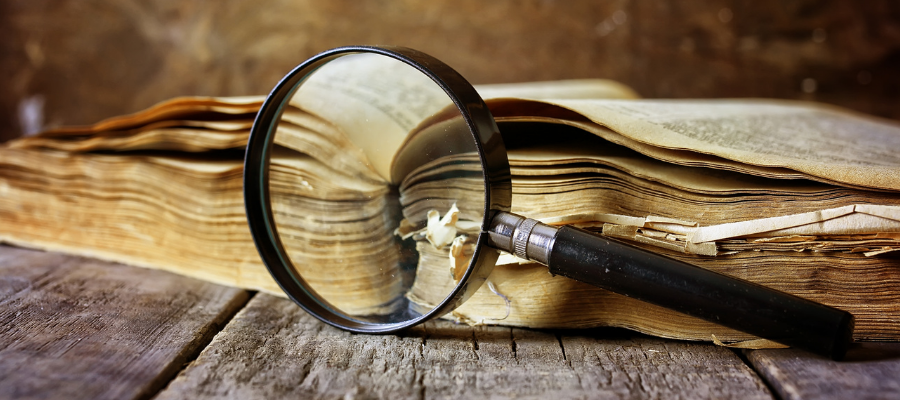
 I believe the ability to gather, organize, distill and share information is a key to success as a creator in today’s hyper-fast, disruptive business environment. I’m always looking for new ways to think about this process.
I believe the ability to gather, organize, distill and share information is a key to success as a creator in today’s hyper-fast, disruptive business environment. I’m always looking for new ways to think about this process.
That’s why I was totally intrigued when my colleague Carla Johnson shared a 3-step process for distilling observations in her new book, RE:Think Innovation: How the World’s Most Prolific Innovators Come Up with Great Ideas that Deliver Extraordinary Outcomes.
In it, she talks about the importance of being keenly observant, recording your observations and then having a way of distilling them and discerning the patterns contained within them. She describes this three-step process as a precursor to brainstorming potential solutions:
1. Scrutinize
“What are all the ways in which two or more things share a common element? For example, a hipster tattoo artist with low-slung pants, a white-haired priest, and an exotic dancer may all appear drastically different. But, believe it or not, they have a lot in common. The same goes for the flagpole outside a school, the billboard advertising a new retirement community and a radio tower on the horizon.”
Placing your observations and ideas on a visual canvas enables you to capture them quickly, without worrying about their structure. It can also help you see patterns and relationships between them more easily than with a linear list of them.
In the image below, I added the personalities that Carla mentioned in her description of this stage of analyzing and distilling your observations and added a few more in Miro. It provides a very flexible environment for capturing ideas and information in a free-form manner, without imposing a structure on them (as a mind map would).
At this stage of the distillation process, look at what you’ve captured at a very high level. What commonalities are you starting to see?
2. Discern
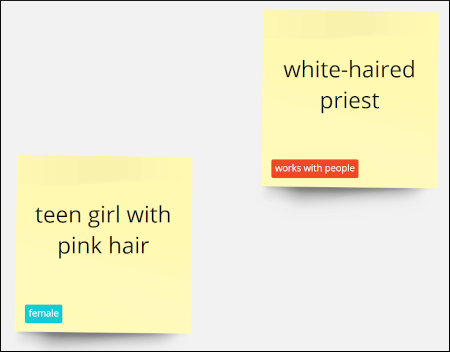 “What meaning do these elements have in relationship to each other? This can come from the smallest of elements. For the hipster, priest, and dancer, it could be something as simple as they make a living working with other people. For the flagpole, billboard, and radio tower, maybe one of the commonalities is that they all signal something.”
“What meaning do these elements have in relationship to each other? This can come from the smallest of elements. For the hipster, priest, and dancer, it could be something as simple as they make a living working with other people. For the flagpole, billboard, and radio tower, maybe one of the commonalities is that they all signal something.”
At this stage of the process, I’ve used Miro’s tagging capability to start visually classifying the personalities contained in my observations. Each sticky note can have multiple tags. They’re easy to create, add and remove from your notes, so you can play around with multiple ways of tagging and categorizing your observations until you settle on one that works for you.
3. Identify
“What are the bigger patterns that arrive from these common elements? Go through your list of observations. What patterns do you start to see? Give each grouping a label. With our example, the three people could be the start of a group called ‘Pleasure’ or even ‘Sin.’ For the flagpole, billboard, and radio tower, the bigger meaning could be “Communication.” Then you may add in some other observations that fit the communication category, such as a stop sign, someone saying hello, and a turn signal on a car. There are no rules on what you choose to name the groups. The labels only need to reflect the spirit of the observations.”
In this third and final stage of the distillation process, I have moved sticky notes with the same tags into loose groupings, and have added frames around them to emphasize these groups. As Carla suggests, I have labelled these frames with names that reflect the spirit of the observation. If a sticky note has more than one tag, you can easily duplicate the note and place an instance of it within each group.
Don’t be afraid to play around with your ideas and observations. Try moving them around into different groupings and arrangements. Each time you do so, you change their context – and that’s the key to uncovering new patterns and relationships between them.
One limitation of Miro for this application
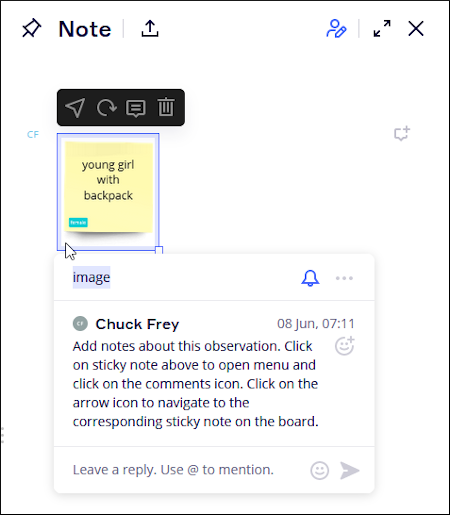 I found Miro to be an excellent tool for this exercise. But I encountered one area where it’s not as flexible as I had hoped. Sticky notes are similar to the nodes of a mind map in that they need to have a very brief title – a few words at the most.
I found Miro to be an excellent tool for this exercise. But I encountered one area where it’s not as flexible as I had hoped. Sticky notes are similar to the nodes of a mind map in that they need to have a very brief title – a few words at the most.
Observations are often more detailed and nuanced. In a mind map, it’s easy to capture this extended information in a topic note. In Miro, it’s not as easy.
The application has a “visual notes” feature that opens in a vertical panel on the right side of the workspace. It’s intended as a collaborative tool, where team members can share ideas, opinions and other thoughts. They exist somewhat independently of the sticky notes in the workspace. I say somewhat because Miro does give you a crude way to connect visual notes to sticky notes.
You must drag and drop the sticky note into the visual notes pane. Miro creates a visual representation of the sticky note in the notes pane, which acts as a “pointer” to that note within your workspace. If you click on it, Miro will re-orient the workspace to display the corresponding sticky note. You can then add your extended information as a comment in the visual notes pane.
Ideally, I’d love it if Miro enabled users to “embed” extended notes within sticky notes, but that’s not the way it’s designed. It’s intended, first and foremost, as a small group collaboration and brainstorming tool.
What I like about Carla’s 3-step distillation process
In my F.A.S.T. framework course, I devote an entire lesson to processes for distilling the information and ideas you’ve captured in a mind map into a cohesive whole. In it, I share a number of techniques for making decisions about how to think about the content of your mind map and how to whittle it down to the essential information. But I’ve never seen an approach that’s as nuanced as the one Carla suggests.
Rather than just diving in and starting to optimize the information, observations and ideas you’ve collected, she recommends a slower, more deliberate approach that should yield some deeper insights than the methods I recommend.
The other thing that makes her 3-step process unique is that it’s not focused on distilling your ideas, but your observations – the research you do and the information you collect BEFORE you begin brainstorming.
In Carla’s way of thinking, rich data collection and observation at the beginning of the creative process enriches your ability to generate innovative solutions.
Key takeaways
- Get in the habit of capturing your ideas and observations
- Capture them in a format that enables you to visually display them in a free-form arrangement
- Look for similarities and patterns in the information and observations you’ve collected
- Don’t be afraid to tag and move these “idea objects” around in different arrangements – a powerful way of playing “what if?” with them!

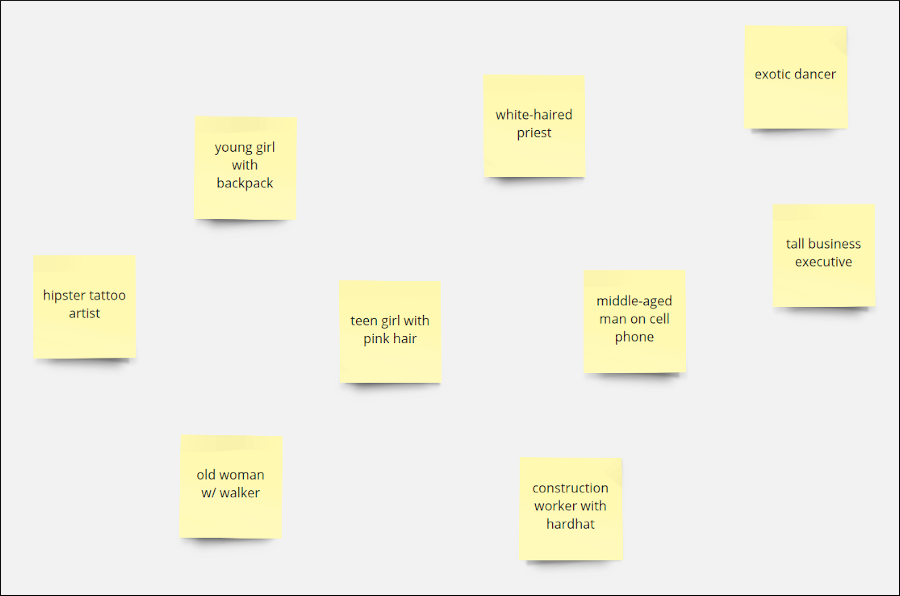
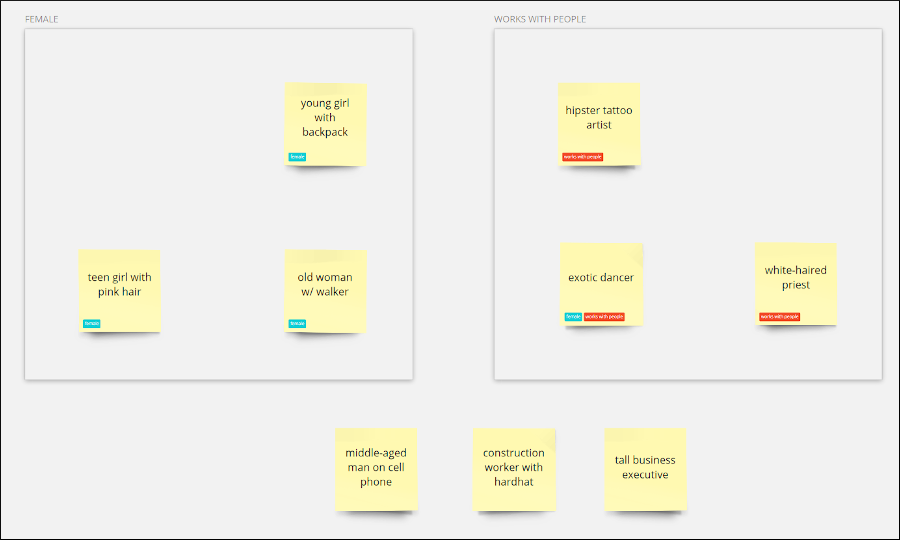
Leave a Reply